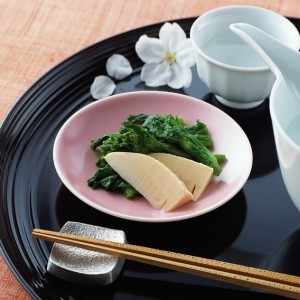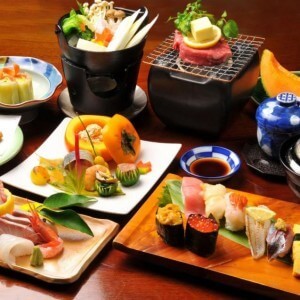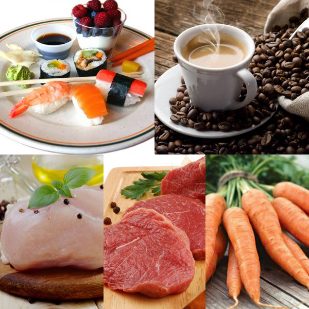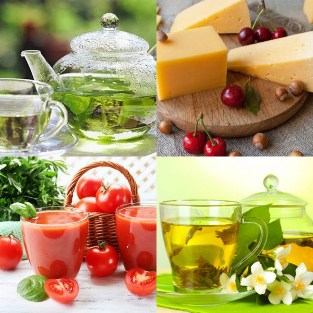
The Japanese diet is a low carb and low calorie diet developed by Japanese nutritionists, but the protein menu allows you to lose 10 kilos in 2 weeks.
Too heavy these days, many people call the payment for an incredibly fast lifestyle. We are in a hurry to live, in a hurry to work, in a hurry to eat. . . In addition, we often eat on the run and with that, as they say, God will send. And in the 21st century, God sends us burgers, hot dogs, cheeseburgers, and sodas. . . “What to do? Do not spend precious minutes at lunch in a restaurant or what? ! - to cook in the kitchen yourself when the company is "on fire"? Here they say that the whole successful world lives like this and nothing. "This excuse is used by a large number of people who live an active lifestyle. And when your favorite jeans do not fit, when you need to buy a longer belt, when between a seductive skirt that fits well at the waist and an ugly shapeless style with elastic, then we choose another, then, of course, it's time to come up with a new excuse. Well, actually - all of this is of course not the result of improper nutrition, but simply. . . thick bone. Yes, yes, and there is nothing to do with it, thick bones - it is so, very harmful. And as soon as it starts to grow - all, it is impossible to stop it.
Now let's focus on Japan, a land of enormous opportunity, the highest level of technological development and the incredible speed of life. It seems that if someone does not have time to take a break from proper meals, it's just like the Japanese. But it is surprising that you rarely meet "thick-skinned" among the people of Japan. . . So what's the secret then?
The fact is that Japanese snacks are low-calorie, high-protein, almost fat-free and "bad" carbohydrates. And the principle of the Eastern food tradition is moderation. That is why Japanese cuisine is called one of the healthiest foods in the body.
Taking into account the peculiarities of the Eastern nutritional tradition, a balanced and very effective diet called Japanese was created. In fact, there is almost no food from traditional Japanese cuisine on the menu in this diet. But it is a greater combination of protein, fat and carbohydrate, in the amount that is exactly necessary for the body to get everything it needs without causing, at the same time, "thickening" of bones. There are several food options but the most popular is the Japanese salt-free diet for 14 days. Two weeks of proper "Japanese" nutrition will help "thick bones" lose more than 10 kilos and maintain their results effortlessly for several years.
The essence of the Japanese diet
Those who decide to go "Japanese" must be patient and deviate from the usual ways of eating for two weeks. For many people, dieting may seem like a difficult challenge, but the effects will not be long in coming. But incredible results will continue for several years to come. Only two weeks of "Japanese woman" control - and ten kilos (sometimes even more - it all depends on the initial weight), as it were.
So what's the main secret? Why is the Japanese diet a week better than other nutrition systems for weight loss? In what wonderful way does it help to lose weight even for those who have tried many other diets without success?
It's all about carefully selected products for the food menu - they are combined in such a way as to speed up the metabolic process as much as possible. That's why it's so important to follow all the instructions strictly, eat only the specified, not to "improve" its other products, even if at first glance it seems to be completely interchangeable. It is also not recommended to change the days of the menu.
For many women, her level of "hunger" is important when choosing a diet, as not everyone can fight the willpower of the samurai against their own desires, especially the old instincts of all organisms - hunger. This is why a two-week Japanese salt-free diet is not a "hungry" diet. To follow that, you do not have to chew a single cabbage for weeks and drink low-fat kefir, cursing yourself, your excess weight and those who came with a diet. The Japanese woman's menu includes a place for interesting and delicious recipes. This diet will especially appeal to those whose breakfast usually consists only of coffee. And lovers of meat and fish will not see anything difficult in it. This is the best diet for them.
The essence of the Japanese diet is easy to explain in just two words - ease and effectiveness.
"Japanese" is a low-calorie protein-fiber diet. Carbohydrates, reduced to a minimum in the daily diet, force you to lose weight faster - if you need energy, your body begins to process its own fat reserves in joules. But it is important to remember something else: a Japanese woman's diet does not allow the body to saturate the whole spectrum of vitamins and minerals. Therefore, it is strictly forbidden to go on a diet longer than prescribed (no more than 14 days), so as not to end weight loss in a hospital bed.
And if you want to feel like a real Japanese, you can try Japanese sticks instead of the forks and spoons that are traditional for Europeans. They will not only convey the magnificent spirit of the Land of the Rising Sun, but will teach how to eat slowly and little by little. By the way, this trick is known to many fans of the diet. A leisurely meal can flatter your body and get you full, even after very small meals. In fact, the Japanese should be on a diet for weight loss.

Types of Japanese Diet
The enormous popularity of the Japanese diet among women around the world has led to the emergence of several options for this weight loss system. In particular, dietary options are known:
- Japanese salt-free diet for 7 days;
- for 13 days (the most common diet);
- for 14 days (different from previous 13 days diet, only about one day);
- Japanese woman with green tea;
- Diet Naomi Moriyama.
The Japanese diet for weight loss consists of foods low in calories, carbohydrates and no salt, spices, sugar and sweet sweets, as well as alcohol, so the diet is considered strict. This promotes the rapid breakdown of fat in the body fat as the body finds itself in a stressful state and is forced to burn its own fats and calories.
7-day food menu
The 7 day Japanese diet is both a light version of the traditional Japanese diet but at the same time the 7 day diet is the basis of the whole diet.

Predicted results: 3-5 kilos left in the past.
Disadvantage: The durability of the result is not guaranteed, as the body has not yet had time to adjust to the new metabolic system.
Day 1
Calorie content of daily diet: 700 kcal.
Essentials:
- black coffee;
- chicken eggs;
- fresh cabbage (cabbage / cabbage);
- tomato juice (preferably freshly squeezed);
- low-fat fish.
Breakfast:
- black coffee - it is better to choose espresso, but it is better to forget sugar.
Lunch:
- boiled chicken eggs (2 pieces are possible);
- "Japanese" salad - fresh cabbage and a little vegetable oil, no need to add salt;
- a glass of tomato juice.
Dinner:
- steamed fish - hake, cod, pollock are ideal (no more than 200 grams);
- Japanese salad.
Day 2
Calorie content of daily diet: 1000 kcal.
Essentials:
- coffee;
- crust;
- fish (fatty species);
- cabbage;
- vegetable oil;
- beef;
- kefir.
Breakfast:
- coffee;
- crust - take small, weighs about 30 grams.
Lunch:
- fish, fried or stewed fish - to diversify and increase the consumption of fatty acids, it is better to prefer catfish, salmon, halibut. Not more than 150 grams in total;
- "Japanese" salad.
Dinner:
- beef - boil about 200 grams. Consume without salt;
- kefir - you can drop no more than 200 grams of glass.
Day 3
Calorie content of daily diet: 1000 kcal.
Essentials:
- coffee;
- zucchini / parsnip;
- epli;
- chicken eggs;
- veal;
- cabbage;
- vegetable oil.
Breakfast:
- black coffee - do not forget the sugar cessation.
Lunch:
- zucchini (large enough) or stone root (also large) - brown in vegetable oil (do not use flour or dough for frying, salt is also prohibited);
- apple - do not let go, it is advisable to limit yourself to one fruit.
Dinner:
- boiled chicken eggs - 2 pieces;
- boiled veal - limit your appetite to a 200 gram piece prepared in a salt-free way;
- "Japanese" salad.
Day 4
Calorie content of daily diet: 1000 kcal.
Essentials:
- coffee;
- carrot;
- hard cheese;
- chicken eggs;
- epli.
Breakfast:
- black sugar-free coffee.
Lunch:
- carrots - boil, it is allowed to take 3 larger roots;
- a little cheese - choose from hard varieties, limit yourself to 20 grams;
- raw chicken eggs - one thing is enough.
All the ingredients of a 4-day lunch, if desired, can be combined into one dish - salad.
Dinner:
- apples - some fruits are allowed.
At this point, the feeling of hunger will no longer be as strong as it used to be. Filling comes after small portions of food.
Day 5
Calorie content of daily diet: 800-1000 kcal.
Essentials:
- carrots;
- lemon juice;
- sea fish;
- safi;
- fruit.
Breakfast:
- carrots and lemon juice - grated vegetables and season with juice. You can not add sugar. Also excluded this day from breakfast and coffee.
Lunch:
- fried fish - take about 350-400 grams, variety - some of the sea;
- tomato juice - for diet it would be better to use fresh, prepared ones. Volume - not more than 200 grams.
Dinner:
- fruit - but in no case should you eat, especially before bed, grapes of any kind or bananas. They will cross out all the progress that has been made so far.
Day 6
Calorie content of daily diet: 900-1100 kcal.
Essentials:
- coffee;
- chicken fillet;
- raw cabbage;
- carrots;
- vegetable oil;
- chicken eggs.
Breakfast:
- black sugar-free coffee.
Lunch:
- chicken fillet - limit the dose to 500 g, take meat without skin. Boil in water without adding salt;
- salad - this day you can add a traditional "Japanese" salad by adding grated raw carrots.
Dinner:
- chicken eggs - boil 2 pieces;
- carrots (you can take large) - shredded raw vegetables, season the salad with a small amount of vegetable oil (maybe olive oil).
Day 7
Calorie content of daily diet: 700-800 kcal.
Essentials:
- te;
- fruit;
- beef;
- egg;
- cabbage;
- vegetable oil.
Breakfast:
- tea - it is advisable to choose a good vegetable variety, rich in useful antioxidants.
Lunch:
- beef - boil about 200 grams each. Do not use salt or other spices during cooking;
- fruit - on the last day of your diet you can treat yourself to lunch. But do not forget the ban on the use of bananas and grapes.
Dinner:
On this day of dinner, as a reward for endurance, you can choose any dinner from previous days. For example, choose a version of beef, eggs and coleslaw seasoned with olive oil.
This will put an end to the diet for some. For those who have chosen longer versions of the Japanese woman, Day 7 is only an equator of work to change oneself.
For those who are not accustomed to eating by counting calories, "Japanese" seems at first to be a rather difficult option to lose weight. But the discomfort is noticeable only in the first few days - then the body adapts to small portions of food, begins to eat up faster. After 5 days of a new diet in the body, the first stage of restructuring begins to speed up the metabolism - the main goal of any diet is to lose excess weight, excess fluid is removed, edema disappears. For best results in conjunction with diet, you can take a course in cellular massage.
Japanese diet for 13 days
The 13-day Japanese diet is the most popular. This version is considered a complete weight loss course.
Predicted results. If you are ashamed to follow all the prescriptions, at the end of the 13 days, you will need about 10 kilos and about 30 cm in volume (sometimes more).
How is it different from the 7 day option? In fact, it's a sequel to the light version of The Japanese Woman. That is, you must go through 7 days of "Japanese" life and start on Day 8 again and repeat days from the first to the sixth.

Japanese diet for 14 days
The basis for the 14-day version of the Japanese diet was also the 7-day menu, albeit with a few nuances. The main difference from the first two options is that in the first week you have to follow the 7-day menu strictly and the second week to eat according to the same program, but in reverse order. This means that the diet of the eighth day will correspond to the diet of the last day 7 days, on the ninth day - menu of the 6th day, on the tenth - menu of the 5th day. . . And according to this principle, keep going until the end of the weekend. As a result, complete the last 14 days of the diet with the diet on the first day of the 7-day issue of "The Japanese Woman".
From the 8th day of nutrition in the diet, the body activates the detoxification process and, thanks to the salt-free nutritional principle of intercellular cells, excess fluid is removed and this completely eliminates edema. It is important that it is in the second week of the diet that the body gets used to a new metabolic rate. Thanks to this, even after switching to a regular diet (usually - this does not mean eating back in the bowls before bedtime, but you also do not have to live in "hunger" mode) the body does not gain weight, on the contrary -fatwill be burned as soon as during the diet. This wonderful effect will last for about 2 years. But provided the diet is maintained properly. Those who have already experienced the work of a "Japanese woman" claim that this year, after completing the diet, the weight will continue to adjust downwards. If you repeat the "Japanese woman" again (but not until six months after the first course), it is in fact, a year, almost effortlessly, to get rid of 20 kg of excess weight.
Diet and salt
Have you ever wondered why almost every more or less effective diet contains a taboo on salt? The thing is, according to experts
1 gram of salt holds a whole liter of fluid in the body.
And this is no more than one kilogram of excess weight. In addition to the false excess weight, where thanks to salt, weight does not accumulate due to the fat layer, but due to stagnant fluid, excessive consumption of salt causes other problems for humans. Even a few days of salt-free meals can lower blood cholesterol levels and improve the condition of blood vessels.
Of course, it is impossible to eliminate salt completely from consumption and it can not be done. But the "Japanese woman's" menu contains products that already contain a certain amount of salts - which are sufficient for the normal functioning of organs. Especially organic salt is found in some vegetables, fish, meat. It is impossible to eat canned vegetables, smoked meats, semi-finished products during the diet - they all have quite a large amount of table salt in their composition.
Green tea
In addition to the classic version of the Japanese diet, there is also an option in the menu that instead of coffee it is recommended to use green tea. Many nutritionists consider this variant of the "Japanese woman" more beneficial for the body.
Given that the Japanese diet is based on a protein diet, it is important that green tea (especially in Japanese form) contains a large amount of protein and in terms of its nutritional value, this drink is not inferior to legumes.
Another plus in favor of vegetables is the presence in the composition of antioxidants that protect the body from toxins and promote the elimination of toxins.
Third, and this is probably the most important thing for those who are losing weight, the unique chemical composition of green tea helps to speed up metabolism by 4 percent (60 calories are burned daily more than without green tea).
The Japanese vegetable diet lasts for 2 weeks. The components are almost the same as in the classic version of "Japanese", although there are still excellent features.

Detailed Japanese Green Tea Diet
Day 1 / Day 14
Breakfast:
- green tea - glass;
- fat-free cottage cheese - 150 g.
Lunch:
- cabbage, boiled with butter - 300 g;
- boiled chicken eggs - 2 pcs. ;
- fresh apple - glass.
Dinner:
- vegetables in salad or steamed;
- boiled or steamed fish - 200 g.
Day 2 / Day 13
Breakfast:
- green tea - glass;
- hard cheese - 2 pieces;
- toast or diet biscuits.
Lunch:
- boiled or raw cabbage, seasoned with oil;
- boiled fish;
- green tea - glass.
Dinner:
- vegetable salad;
- boiled veal - 300 g;
- boiled chicken eggs - 2 pcs. ;
- Japanese green tea - glass.
Day 3 / Day 12
Breakfast:
- Japanese green tea - glass;
- food cookies.
Lunch:
- boiled zucchini / cauliflower;
- apple - 1 pc.
- green tea - glass.
Dinner:
- yellow-green vegetable salad;
- boiled veal;
- boiled chicken eggs - 2 pcs.
Day 4 / Day 11
Breakfast:
- Japanese green tea - glass;
- fat-free cottage cheese - 150 g.
Lunch:
- raw grated carrots with olive oil;
- chicken eggs;
- green tea without sugar.
Dinner:
- green tea;
- fruits (not grapes and bananas).
Day 5 / Day 10
Breakfast:
- green tea - glass;
- bread cubes with jam - 2 pcs.
Lunch:
- boiled fish - 200 g;
- tomato juice - glass.
Dinner:
- green vegetable salad;
- hard cheese - 2 pieces;
- green tea - glass.
Day 6 / Day 9
Breakfast:
- rye flour operations - 2 pcs. ;
- Japanese green tea - glass.
Lunch:
- raw cabbage / boiled with olive oil;
- boiled chicken without skin - 400 g;
- Japanese tea - glass.
Dinner:
- carrots (boiled / raw);
- boiled eggs - 2 pcs. ;
- unsweetened green tea.
Day 7 / Day 8
Breakfast:
- Japanese tea - glass;
- cheese (some hard varieties) - 2 small pieces.
Lunch:
- boiled veal - 200 g;
- boiled / steamed vegetables;
- green tea without sugar - glass.
Dinner:
- fruits - all;
- Japanese green tea - glass.
The effectiveness of this variant of the Japanese diet is enhanced by the addition of green tea to the diet and the variety and delicious menu makes it easy to withstand periods of food restrictions. Repeat the diet - not until a year later. And so it was achieved in the two-week results lasted longer, in the future it is advisable to follow a healthy lifestyle, eliminate tobacco and limit the dose of alcohol and monitor proper nutrition in daily life.

Main courses
Whether you choose a Japanese diet, any of them will have a traditional coleslaw and cooked meat. These dishes can be prepared in different ways. But remember that they are part of the diet and the cooking process is only slightly different from the cuisine. regular meals.
Making the right Japanese salad:
- Take raw or low-cooked cabbage (common cabbage or cabbage).
- Finely chop.
- Easily squeeze out excess moisture.
- Season the prepared salad base with olive oil or sesame oil.
- Stir and brew.
Diet cooked meat
- Prepare meat. If it is chicken, remove the skin. Peel the veal or beef from the film.
- Rinse thoroughly with cold water.
- Put the meat in a saucepan, cover with very cold water.
- After boiling, drain the water, rinse the meat and refill with water and turn it on.
- Cook until tender without adding spices.
Tip: Add onion, small carrot and some vegetables to the water to improve the taste during cooking. Many people are wondering how to replace beef in the Japanese diet. It is permissible to add young veal to the menu, which is easier to digest, but with the same chemical composition as beef.
How were products selected?
Almost all sources say that the list of foods allowed in the Japanese diet is special and should not be changed. So what is the secret of this particular diet?

Coffee. Many people start the day with this fragrant drink. A cup of black ground coffee serves as a traditional breakfast and in the Japanese diet.
What is the purpose?
Black sugar-free coffee, which has a stimulating effect, helps the body wake up faster and start the process of burning calories. And since there is no diet to eat in the morning, the body begins to produce energy for its own reserves - subcutaneous fat.
You can diversify the taste of your morning drink by adding vanilla, dark chocolate or citrus fruits. Add additional ingredients in small portions.
Cabbage. This vegetable for the diet was not chosen by chance. In addition, cabbage is one of the vegetables with a so-called "minus" calorie content (the body consumes more energy in its digestion than it receives).
What is the purpose?
Cabbage, white or cabbage, has a strengthening effect on the vessel walls, lowers cholesterol levels and cleanses the intestines. For people who are prone to bowel movements, it is better to boil cabbage only before use.
Olive oil. A teaspoon of oil added to the salad normalizes metabolism, has a beneficial effect on the liver, kidneys and pancreas.
Egg. This product has good nutritional properties and is a great source of protein, fat and carbohydrates, as well as many vitamins and minerals.
Tomato juice. Nutritionists call it the healthiest. The unique chemical composition of tomatoes prevents cardiovascular disease and speeds up metabolic processes in the body, improves mood and has a positive effect on the nervous system. It is best absorbed without salt, which is especially important for a salt-free diet.
Fish. Known for its ability to remove toxins and toxins quickly. It is a valuable source of protein and amino acids. It affects the body as a preventive measure against stroke.
Fruits. Generally, during the diet, the amount of carbohydrates consumed should be significantly reduced. But it is completely undesirable to exclude from the diet - they are an important source of energy. The body gets "proper" carbohydrates along with fruits. But from the diet it is better to exclude bananas and grapes, which contain a lot of sugar.

Naomi Moriyama's Diet
It's hard not to believe in the success of the Japanese diet, especially for those who nevertheless decided to try it themselves. But sooner or later many people ask themselves: why is this diet called the "Japanese diet" if there is almost nothing on the menu? from traditional dishes for the Land of the Rising Sun. But there is an explanation for this. According to one version, this original diet is a nutritional development of the Japanese clinic "Yaelo".
But there is another version of "Japanese", created by marketing director Naomi Moriyama - in response to French woman Mireille Guiliano, author of the book "Why French Women Don't Get Fat. "In fact, according to research, the French are not the narrowest in the world. The least obese people live in Japan - only 3 percent, but in France there are about 11% donuts and in the United States - more than 32%. So Naomi has collected nutritional rules that are typical of her people and adapted them to their diet.
Food Rules from the Land of the Rising Sun
Easterners eat almost 100 kinds of different foods a week, but the total caloric content is more than a quarter lower than, for example, a weekly calorie intake in the United States. And the only secret to Japan's reconciliation lies in a simple rule: fill your stomach 80 percent.














































































